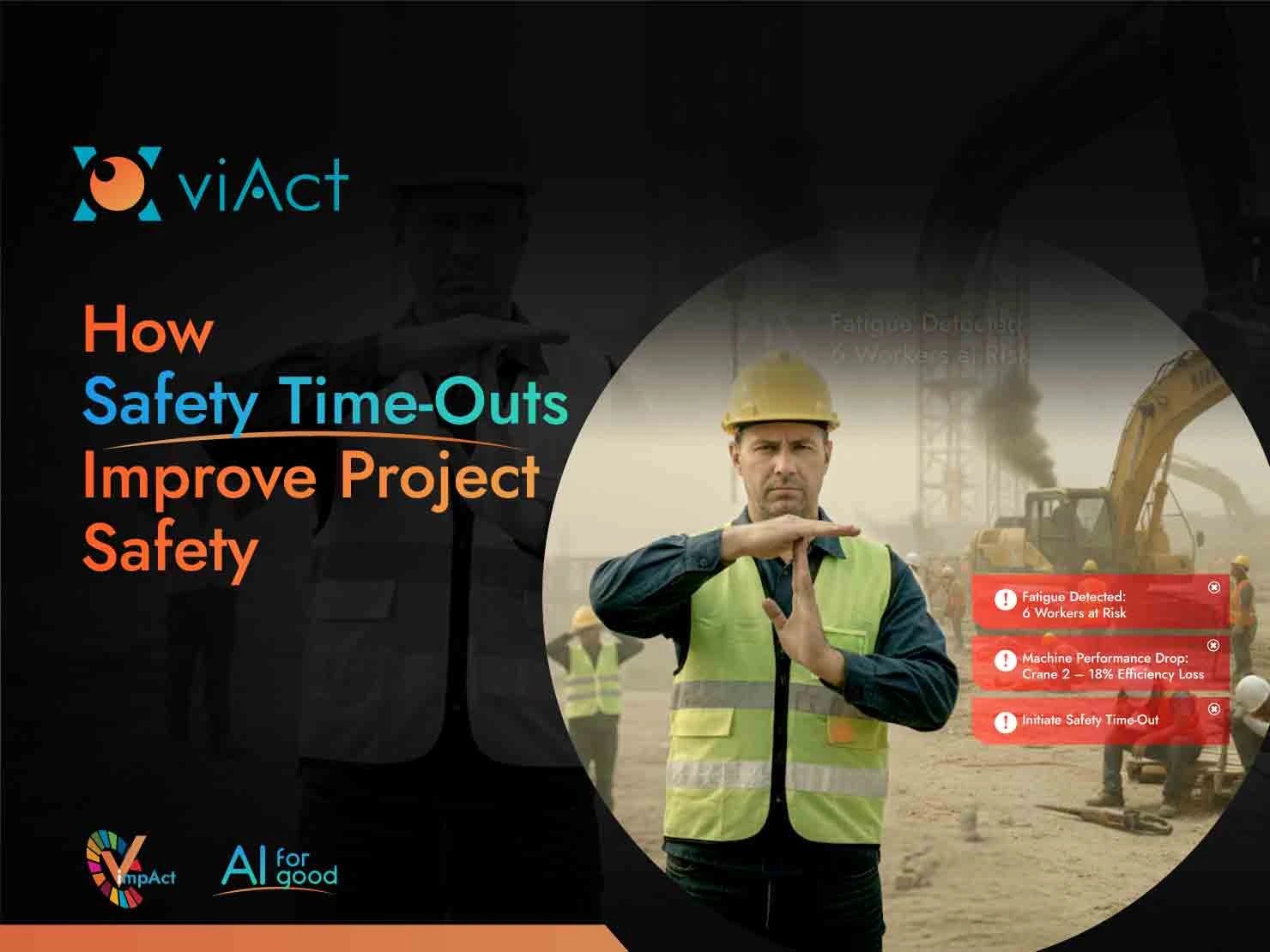Every day, millions of workers step onto high-risk industrial sites from construction areas to manufacturing floors, oil and gas platforms, and mining operations across the globe. As these sites grow more complex, with tighter deadlines and faster workflows, the risk of incidents rises proportionally.
The World Health Organisation points out how crossing the 55 hours of work per week mark leads to 35% higher chances of a stroke and 17% higher risk of dying from ischemic heart disease.
In response to these realities, Safety Time-Outs (STOs) have emerged as a strategic intervention for high-risk industries. By pausing operations — even briefly — teams can reassess their safety posture, recalibrate risk controls, refresh the workforce safety engagement on hazards, and reduce the total recordable incident rate (TRIR).
But today’s STOs go far beyond a traditional checklist exercise.
Modern AI tools analyze video analytics, inspection data, and near-miss reporting to recommend the optimal time for a Safety Time-Out — predicting when human error risk is highest. This integration of human awareness and machine intelligence has made STOs one of the most logical, strategic, and outcome-driven safety measures for high-risk industries.
Understanding Safety Time-Outs (STOs)
At its core, a Safety Time-Out is a planned operational halt where EHS teams evaluate ongoing work conditions, review safety systems, and address lapses before they evolve into incidents. It’s not an interruption but a recalibration of focus.
The Ministry of Manpower (MOM), National Trades Union Congress (NTUC), and the Workplace Safety and Health Council (WSHC) in Singapore strongly advocate the implementation of STOs across all high-risk industries. Their official directives recommend that companies conduct STOs to:
-
Review the effectiveness of Workplace Safety and Health (WSH) systems.
-
Assess whether equipment and machinery are fit for operation.
-
Verify worker competence and refresher training needs.
-
Identify systemic lapses and take corrective and preventive actions.
These recommendations have proven highly effective as Singapore continues to rank among the top countries globally with a five-year average workplace fatality rate of 1.1 per 100,000 workers.
However, as heavy industrial operations become more complex, the traditional approach of conducting STOs manually is being reimagined in 2025. The rise of AI-driven EHS systems is enabling organizations to transform STOs from periodic checks into continuous, intelligent interventions that anticipate risks before they demand a halt.
The Role of AI in Modern Safety Time-Outs (STOs)
AI-based STOs introduce a paradigm shift — they convert what was once a reactive safety measure into a data-informed, predictive process for preventing workplace incidents. Using AI video analytics, computer vision, and predictive intelligence, modern EHS systems can now analyze live site data to determine when, where, and why an STO should occur.
For instance, Safety Time-Outs in construction projects use real-time EHS analytics to detect unsafe scaffolding movements or improper harness usage, automatically triggering alerts for a pause before the hazard escalates. Similarly, in manufacturing, AI-powered process monitoring can identify repetitive strain risks or deviations in machine behavior — prompting a pause for recalibration or inspection.
By enabling smart decision-making and automated recommendations, AI ensures that STOs are not just compliance-driven, but context-aware — focused precisely on areas where risk is rising.
Making Safety Time-Outs (STOs) a Strategic Layer in Project Safety
In many high-risk industries, project safety management relies on layers of control — administrative, procedural, and technological. Time-outs form the strategic checkpoint layer, ensuring that all other controls are functioning effectively. When enhanced by AI, STOs evolve into a decision-support mechanism that connects real-time site insights with operational responses.
The following table illustrates how AI-powered STOs enhance each dimension of project safety management:
|
Manual identification during inspection or incident. |
Automated detection via AI video analytics & IoT sensors analyzing unsafe actions or environmental deviations. |
|
|
Scheduled periodically or after incidents. |
Dynamically triggered based on predictive analytics and safety trend monitoring. |
|
|
Based on the supervisor’s judgment and experience. |
Supported by AI-generated insights, risk scores, and historical data patterns. |
|
|
Logged manually; prone to delay or oversight. |
Auto-documented and assigned in digital EHS dashboards with corrective timelines. |
|
|
Limited to the immediate incident context. |
Continuous improvement loop via AI feedback, learning from recurring patterns. |
Executing Safety Time-Outs: A Step-by-Step Approach
Implementing an STO requires structure, consistency, and data-driven clarity. Below is a guide EHS leaders can follow to make STOs more than a formality — turning them into a powerful corrective action management (CAM) tool.
Step 1: Strategic Planning
STOs must be deliberately scheduled at key project milestones — such as before starting high-risk tasks, post-incident reviews, or during environmental changes. AI tools can assist by suggesting optimal time windows when risk exposure peaks, helping safety managers deploy STOs with precision rather than disruption.
Step 2: Define Objectives and Data Sources
Before each STO, define measurable goals: is it to reassess heavy machinery safety, evaluate worker compliance, or verify procedural accuracy? Data from AI analytics, digital checklists, and safety observations should guide these discussions. For example, in a refinery, heat maps from AI cameras can visually indicate zones where worker density is unusually high, signalling areas requiring review.
Step 3: Conduct the STO with Stakeholder Collaboration
During the STO, all team members — from supervisors to site engineers — should participate. The process typically includes halting work, conducting a risk assessment, reviewing near-misses, and validating corrective actions. AI dashboards can visualize hazards detected in the past 24 hours, allowing teams to discuss them in real-time. This encourages accountability and shared learning.
Step 4: Record, Assign, and Track Corrective Actions
Every STO must culminate in documented corrective actions. AI-driven platforms automatically generate these tasks, assign responsible owners, and set deadlines. Instead of relying on fragmented spreadsheets, EHS leaders can monitor progress in a unified dashboard — ensuring closure verification and post-action evaluation.
Safety Time-Outs and Corrective and Preventive Action (CAPA) processes share a unified goal: eliminating root causes of hazards and ensuring non-recurrence. When combined, STOs feed real-time insights into the CAPA framework. For example, AI-powered STO reports can highlight recurring hazards such as equipment overloading. CAPA systems then use this data to design preventive solutions like load monitoring alerts, operator retraining, or workflow redesigns.
Step 5: Measure Impact and Close the Loop
Once corrective actions are implemented, AI analytics perform impact assessments — quantifying whether safety alerts have reduced and compliance has improved. This feedback loop transforms STOs from a compliance ritual into a continuous improvement mechanism. In mining operations, for example, post-STO data often reveals a direct reduction in near-misses after adjustments to equipment access zones or worker training schedules.
Thus, an STO is not merely a one-time pause — it’s the first step in a continuous risk reduction cycle, where AI bridges real-time site conditions with long-term safety strategy.
Making Safety Time-Outs (STOs) a Project Safety Culture
From an EHS leadership perspective, the real success of STOs lies not in their frequency, but in how deeply they are embedded into a project’s safety culture. A one-off STO can correct immediate risks, but when the practice becomes a predictable rhythm of reflection and recalibration, it transforms the organization’s collective safety mindset.
1. Communicate the Purpose Clearly
STOs must never be perceived as downtime or blame sessions. Leaders need to set the tone — that STOs are an investment in precision, safety, and performance continuity. At high-risk sites, where every minute counts, teams are more receptive when they understand why operations pause.
For instance, when AI analytics trigger a time-out due to recurring lifting gear imbalance, supervisors can present real-time dashboards showing how such anomalies, if ignored, can lead to severe load-handling accidents. By linking STOs with data-backed justifications, leaders help workers see that every pause is a step toward zero harm — not lost productivity.
2. Use Data Storytelling
Data is powerful, but stories make it memorable. Using AI analytics, EHS teams can visualize STO outcomes — before-and-after heat maps of risk zones, trends in hazard reduction, or compliance improvements across shifts.
|
Quick Case Insight: A leading Singapore-based construction firm with over 12,000 workers aligned its safety goals with the Ministry of Manpower’s WSH 2028 strategy. Facing recurring scaffolding and lifting hazards, the company adopted viAct AI-powered platform to trigger Safety Time-Outs in construction whenever risks were detected on site. These brief, data-driven pauses allowed supervisors to reassess conditions, verify compliance, and act immediately. Within six months, the firm saw a 10× rise in safety scores, 7,000+ hours saved, and a 46% drop in repeat incidents. What began as an intervention soon evolved into a culture of continuous, AI-enabled safety awareness. 👉 Read the complete case study here: https://www.viact.ai/case-studies/singapore-construction-giant |
Data storytelling transforms compliance metrics into motivation. When workers can see tangible proof of progress, the “pause for safety” becomes a shared achievement rather than an imposed routine.
3. Align STOs with Performance KPIs
Institutionalizing STOs requires integrating them into operational and safety KPIs. Metrics such as:
-
Reduction in Lost Time Injury Frequency Rate (LTIFR)
-
Decrease in near-miss frequency
-
Improvement in Mean Time Between Failures (MTBF)
-
Reduction in unplanned equipment downtime
– should be linked directly with STO activity data.
4. Reinforce with Continuous Feedback
Each STO should feed into a continuous learning loop. AI helps analyze cross-project patterns — identifying whether the same hazard category reappears across different sites or shifts. EHS leaders can use these insights to design refresher modules or modify standard operating procedures (SOPs).
Conclusion: Safety Time Out Pauses That Drive Progress
Safety Time-Outs are more than operational pauses; they’re strategic intelligence checkpoints. They align human vigilance with digital foresight — ensuring that every decision is backed by data, not just intuition.
With the Ministry of Manpower’s emphasis on proactive safety measures and the growing role of AI-driven analytics, STOs are fast becoming the benchmark for industrial resilience. For EHS leaders, this is the time to shift from reactionary risk management to predictive, AI-empowered prevention — because sometimes, the smartest move forward begins with a pause.
1. Can AI really identify when an STO is needed?
Yes. AI continuously monitors video feeds, IoT sensors, and inspection data.When it detects unsafe proximity, fatigue behavior, or machinery anomalies, it flags an event requiring an STO.
This ensures STOs are based on real-time risk intelligence rather than fixed schedules.
2. Can AI-powered STOs help reduce human error in inspections?
AI video analytics and machine learning replace subjective judgment with consistent, automated detection. This minimizes oversight and ensures that hazards like unsecured edges or improper lifting are never missed.
3. Is AI deployment for STOs costly or complex?
Not anymore. AI EHS platforms like viAct can be deployed within weeks, using existing CCTV with both Cloud-based and on-prem deployment options. No new hardware is typically required — it’s a software-layer solution with 100+ pre-built modules designed for easy scalability.
4. Can I customize STO parameters for my specific site or operation?
Yes. AI platforms allow you to define triggers by:
-
Activity type (welding, lifting, excavation)
-
Risk level (low, medium, high)
-
Environmental conditions (heat index, confined space).
This flexibility makes STOs site-specific and data-driven.
5. Where can I find a reliable AI system for conducting STOs?
Solutions like viAct AI safety management system specialize in automating Safety Time-Outs across construction, manufacturing, and other high-risk industries. They integrate hazard detection, STO triggers, corrective actions, and compliance dashboards — making AI-led project safety comprehensive and continuous.
They offer their solutions across the globe, like Singapore, Hong Kong, Saudi Arabia, UAE, Oman, Qatar, Bahrain, Kuwait, Africa, Europe, and North America.
Looking for Smarter Ways to Manage Safety Time-Outs?



